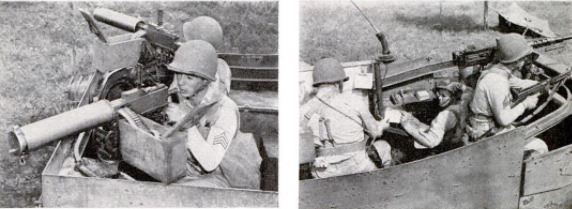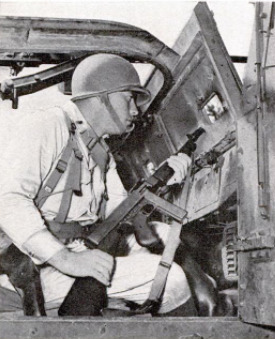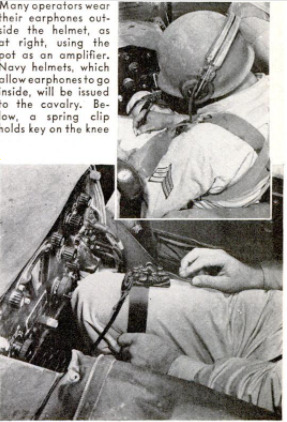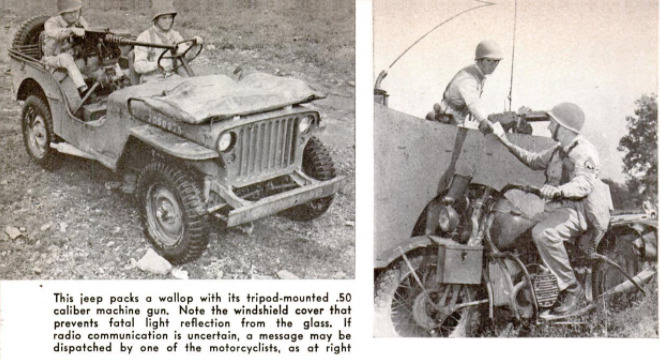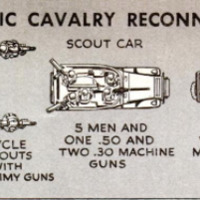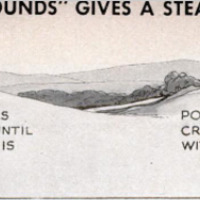-
Titolo
-
U. S. troops on armored transports
-
Article Title and/or Image Caption
-
Title: Troops on wheels
-
Subtitle: A modern cavalryman is a rough-riding, hard-hitting member of a tiny task force that does a big job
-
extracted text
-
WHEN America’s new Army swung in-
to action against the Nazi foe in
North Africa, and on every important fight-
ing ground since, our battling divisions went
into combat behind a fast-moving screen of
highly trained mechanized cavalry—scout-
ing the enemy, probing delicately for his
strengths and weaknesses, pouring back a
flood of vital information that enabled our
commanders to dispose their troops to the
best advantage.
This reconnaissance screen performs one
of the most important services in war. The
men who handle these missions are among
the toughest, bravest, and smartest troops
we can boast, and they are carrying on a
proud tradition of American arms.
For today’s U.S. cavalryman wears the
crossed-sabers emblem on his uniform as
proudly as any swashbuckling trooper of
the glamorous past, although the weapon
he yanks out of his leather scabbard is more
likely to be a Tommy gun than a saber, and
the scabbard itself is slung on a burly mo-
toreycle or a go-anywhere jeep.
True, our Army still has crack horse out-
fits for specialized work, but cavalry in
modern war is mainly mechanized, and its
basic function is reconnaissance rather than
combat—even though the nature of their
work requires cavalry detachments to be
among the fightingest units in any army.
The cavalryman in battle lives a life that
can only be described as full and active. He
operates as part of a miniature task force,
usually well in advance of the main body
of troops or far out on the flanks, often as
much as 50, 80, or 100 miles behind the
enemy's forward positions.
His is a slashing action—quick penetra-
tion of border or road guards, a headlong
dash down side roads or trails, a blasting
exchange of fire with an enemy strong
point or counter-reconnaissance patrol.
Then in a moment he becomes a stealthy
intruder, horsing his vehicles up into the
brush or woodland, hiding them under trees,
putting out cat-footing patrols to probe for
hostile encampments in the dark.
Always the cavalryman concentrates on
getting the information, protecting it, and
getting it back to the command post. In ful-
filing his duties he must be tough as a
commando and smart as a G-2 officer.
Mechanized cavalry units go into action
plentiully supplied with technical tools—
Vebicles, weapons, and radio equipment.
Their’ basic roiling stock includes the
powerful armored scout car and the Army's
Dew shaft-driven motorcycles, as well as
the handy midget cars best known to the
public as jeeps, although cavalrymen are
more likely to call them “bantams” or
“quarter-tons.”
Reconnaissance details have thelr own
“heavy artillery” n the form of hard-punch-
ing 37-mm. antitank guns and 81mm. mor-
tars. The cars also carry heavy and light
machine guns, which, added to the rifles,
carbines, and submachine guns of the me,
20d up to & very respectable fire power.
Other weapons include ground mines, smoke
and gas charges, and demolition kits with
TNT charges, fuses, and detonating cord.
Radio communication naturally is the
heart and soul of fast reconnaissance work.
Cavalrymen working deep in enemy terri.
tory can feed & steady flow of reports to
headquarters by means of the powerful
Signal Corps code transmitters mounted In
scout cars. For shorter distances, and par-
ticularly for advance reconnaissance when
the heavier vehicles are ia concealment and
small observation parties go out In Jeeps or
on foot, the cavalry has a portable receiver
transmitter of special design, working with
voice transmission.
"The basic unit of organization for mecha.
nized cavalry is the section, made up of a
scout car, four Jeeps, and two motorcycles.
Two sections make a platoon, regarded as
the main tactical unit in reconnaissance
tactics, while three of these platoons make
a troop
A reconnaissance troop is assigned to
each triangular infantry division, while each
of our motorized divisions has a full “recon”
squadron—three regular troops, an armored
support troop, and a headquarters troop.
Headquarters troop handles such matters
as supply, administration, communications,
and motor maintenance. The support troop
is designed as a heavyweight outfit, with
15 to 20 hard-hitting combat vehicles of the
tank type, plus various supplementary cars.
A typical arrangement of a section oper-
ating on a road might find the scout car
preceded by two jeeps and followed by the
motorcyclists and the remaining two jeeps.
The lead jeep, functioning as a point car,
carries a driver and three riflemen, and is
covered and protected by the second jeep,
with two men and a .50 caliber machine gun.
‘The scout car, carrying the section com-
mander, has light armor plate and packs a
punch with a .50 and two .30 caliber ma~
chine guns. The cyclists normally stay close
to the commander, ready to dart ahead or
into a side road on short scouting missions,
or to whirl around and head back to deliver
messages or warn following units of danger.
Each of the two jeeps at the rear carries
three men and a .30 caliber machine gun.
Their main mission is flank protection and
reconnaissance. In an operation where en-
emy heavy units may be encountered—
tanks, mobile assault guns, armored cars,
and the like—one of the rear jeeps probably
would be assigned to tow a 37-mm. antitank
gun.
This road arrangement is capable of wide
variation, of course. If the outfit hopes to
smash through light enemy resistance at
high speed and move on into open territory,
the scout car may lead the way. This means
running the risk of road mines or concealed
artillery, yet in some circumstances the ad-
vantage to be gained might be worth the
try.
Obviously, it takes cracking good soldiers
to carry out these missions, with their wide
range from head-on combat to stealthy
scouting. Cavalrymen are good and they
look it—tough and businesslike in the drab
greenish-gray coveralls which serve as their
battle dress. They are quiet and watchful,
as befits troops who may be spending a good
deal of their time in enemy territory. They
are the kind of soldiers who carry their
weapons along to mess, and disperse under
the trees to eat without being reminded
of it.
The teamwork required in a scout car and
the supporting elements of a section rivals
that of a heavy bomber crew. The com-
mander, to begin with, must have expert
knowledge of all his vehicles, weapons, and
communications equipment, and of the en-
emy’s as well. He must be expert at visual
reconnaissance, have a sound understanding
of intelligence problems to make his reports
to headquarters of maximum value, and
know methods of supply and techniques of
construction well enough to do a swift and
efficient job of demolition if the chance
arises during a sweep through hostile ter-
ritory.
In’ addition, the cavalry leader must have
a good grip on basic infantry combat tac-
tics, as well as the specialized tactics of his
own branch. And he must have a thorough
knowledge of maps, navigation, and orlentn-
tion problems. This latter qualification came
to the fore especially throughout the desert
fighting in North Africa, where many
sweeps of hundreds of mile were carried
out over the trackless sands, depending en-
tirely on compass readings, dead reckoning,
and celestial observations.
The more of these skills a trooper ac-
quires, the better all-around cavalryman he
becomes, although naturally his primary
concern must be his own specialties In the
team setup. Thus the driver's first concern
must be his combat vehicle. Ho has to he
able to handle it across any going from a
concrete highway to a shallow creek and
perform the elementary repairs and main-
tenance the Army classes as “first echelon.”
‘Aside from that, he must know the ways
of camouflage and concealment. Ho must
have a hair-trigger reaction to signals and
commands, and must blend with the other
vehicles on the road as a good taxi driver
blends with fast-moving traffic, anticipating
what the other drivers are going to do.
The cavalrymen who ride the bucking
Jeep must be ready to function as the point
of the column, and keep a wary eye on the
road for buried mines—one of the mechan-
176d troopers’ worst hazards, They must
know how to read maps and keep them-
selves oriented at all times, and must have
special preparation for effective reconnais-
nance, including the ability to Judge num-
bers of men and vehicles on a road, the
approximate size of enemy camps, and the
difference between the enemy's special types
of heavy and light artillery, or heavy and
medium tanks. They must also be expert
Fiflemen and machine gunners, able to lay
down un effective harassing oF covering fire.
Motorcycle scouts ure as tough and handy
ax any men in our Army. It is scarcely pos-
sible to overestimate the courage and physi-
cal ‘stamina Jt takes to chaufteur one of
nese over-powered, war-going kiddie cars
down pounding hard routs, over washboard
or corduroy wurtace, dodging boulders, and
Withering through sandpits, while the other
men of the section enjoy the comparative
luxury of squatting on a steel storage well
and clinging to the relatively stable business
end of 30 caliber machine gun.
“The cyclist is above all clse a road agent
Rot in the old-time sense of the dashing
outlaw who held up stage coaches, but in
new technique of swift investigation of side
roads and suspicious terrain ahead. A motor-
Cyclo can do this Job faster than any other
vehicle. Often a joep and cycle are paired
for an assignment the Jeep to creep into
suspected terrain and defend itself if neces.
nary, the “cycle always ready to rip back
to the main body once the enemy has shown
his strength.
“Another special aptitude of the cyclist In
the trick of running Into trouble, doing a
quick turn, akidding to a stop, and going
into action at once with n Tommy gun or
carbine crows the protecting bulwark of
hia machine.
The radio man has an especially vital
Job, serving as the ears of the scouting de-
Wil. A good
operator not only is alert to receive mes-
sages and quick on the transmission, but
will systematically monitor his radio nets
to pick up collateral information about what
is going on at the flanks or with other
scout cars in the net. He also keeps track
of where the car is at any given time, looks
back frequently to orient himself on the
map board, and in an emergency can jump
up to replace one of the gunners.
All cavalry equipment is in a continuous
process of improvement. Thus the six-ton
M3A1 scout car itself, while admittedly a
very handy vehicle, is regarded in the Army
as more or less obsolescent, and it is no
secret that a more modern combat car will
soon take its place, endowed with heavier
armor, greater fire power, and superior
ground-covering qualities. If the old scout
car had a real fault, it was in lacking versa-
tility and power across country. Our com-
manders hate nothing worse than the spec-
tacle of U.S. Army units getting “road-
bound” and unable to move across fields
and intervening terrain to strike back on a
road beyond enemy blocks.
Elementary in the new cavalry technique
is the “advance by bounds,” in which one
car studies the terrain ahead, and then
rushes at full speed to the next covered
point—a hill crest or road turn—while the
following car waits to cover its move with
fire. That accomplished, the section makes
another bound ahead, accommodating its
maneuvers always to the terrain in which
it is operating.
In dangerous territory, Where the road
is broken and enemy resistance may be en-
countered at any point, the cars may turn
around in the road and back up to the
danger point, thus bringing heavy fire power
to bear over the peak of a hill and main-
taining themselves in position to withdraw
swiftly from a hot spot.
When reconnoitering a village or enemy
camp, the cavalrymen try to do their ob-
servation from the extreme flank or rear.
If an ambush is suspected on a road ahead,
they again prefer the safe method of dis-
mounted reconnaissance from the flank, but
if time is pressing they will switch tactics
and send a car in to slash through while
other vehicles cover the suspected zones
with fire.
More complex operations are not ready
for public discussion now. It should be
enough to set down for the record that the
American cavalryman is a tough hombre on
wheels today—he already was tough!
-
Autore secondario
-
John H. Walker (Article Writer)
-
William W. Morris (Photographer)
-
Lingua
-
eng
-
Data di rilascio
-
1943-05
-
pagine
-
49-52, 208
-
Diritti
-
Public Domain (Google Digitized)
-
Archived by
-
Matteo Ridolfi
-
Marco Bortolami (editor)


